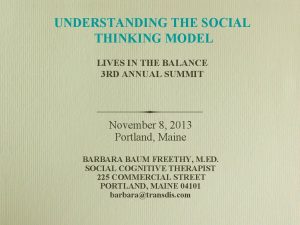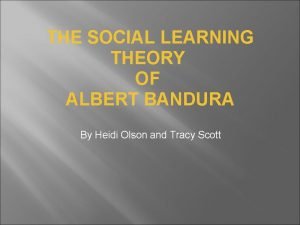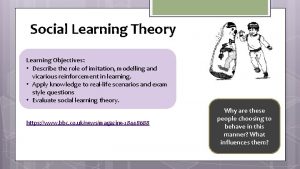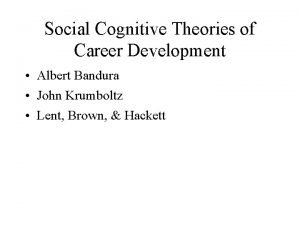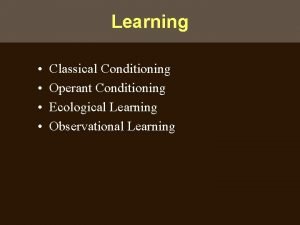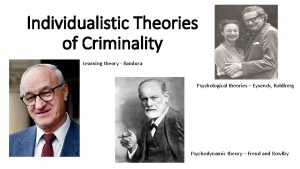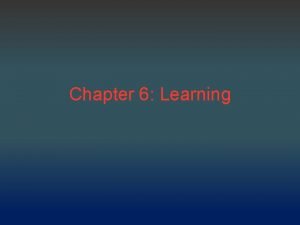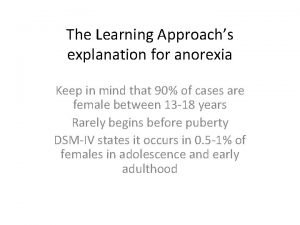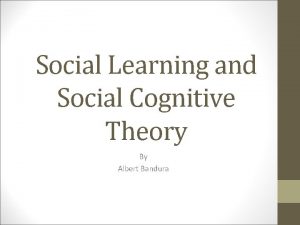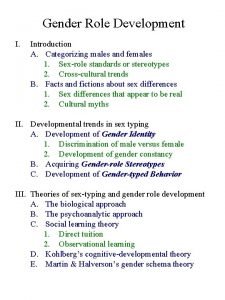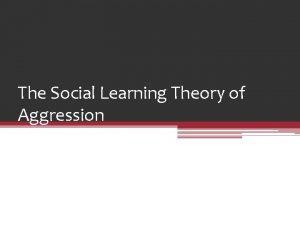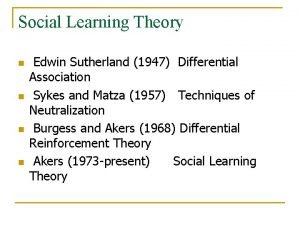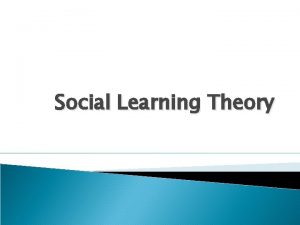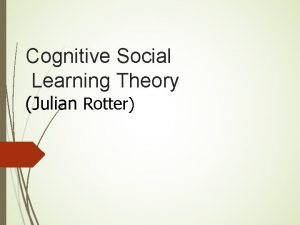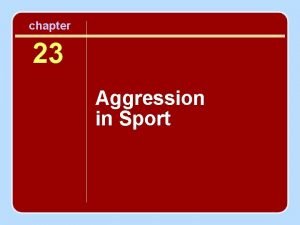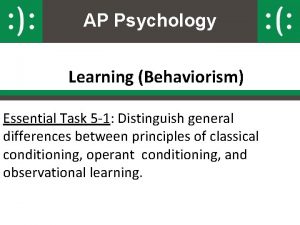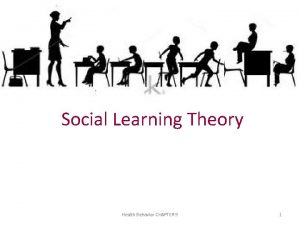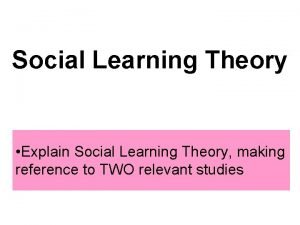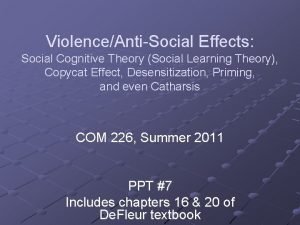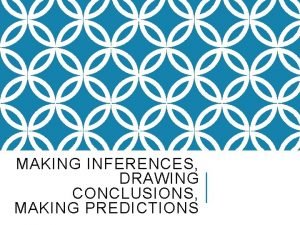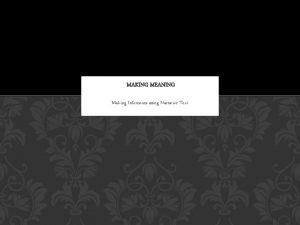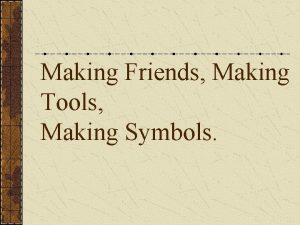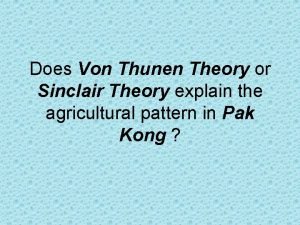Social Learning Theory Explain Social Learning Theory making






















- Slides: 22

Social Learning Theory • Explain Social Learning Theory, making reference to TWO relevant studies

Social-Cognitive theory • Most Behaviorists explain behavior with the ABCs – A Antecedents (Events preceding behavior) – B Behavior itself – C Consequences of behavior • Social-Cognitive theorists emphasize observing others in a social setting


Dollard and Miller (1950) • Theory: most learning is the result of observation, not standard conditioning • Why? – Humans have attitudes, beliefs and expectations • Impact the way we make decisions, reason and solve problems • Soft Determinism – BUT…still not investigating ‘cognition’

Albert Bandura Social Cognitive Theory • behavior is learned and maintained through observation and imitation of others – positive consequences – cognitive processes • Plans, expectations, and beliefs. • Observational Learning – A process in which an individual learns new responses by observing the behavior of another (a model) • rather than through direct experience – Conditioning

Attention: paying attention to the model is a condition of learning Retention: Remembering what the model did Reproduction: People must have the capacity for imitating Motivation: People must be motivated to imitate (importance of model or reward)

Bandura and Aggression

Bandura’s Hypothesis 1. Aggressive models – imitated more than nonaggressive 2. Nonaggressive models – less aggressive than those who observed aggression and the control group (no model) 3. Same Sex Model – Imitate more than opposite sex 4. Gender of Participant – Males are more predisposed than girls toward imitating aggression

Method (Experimental) • Subjects – 36 boys and 36 girls (ranging from 3 – 6 years old) • Experimental Conditions – 24 => control group without model – 48 => two groups (one without aggressive model and one with) • Gender and Model Conditions – 8 experimental group and one control group • Dependent Variable: Level of Aggression – Through Observation

• Experimental Procedure – Observation Stage • Brought children into playroom • invited adult model to join the game – adult was taken into a corner with tinker toy set, mallet, and bobo doll (10 minute period) » Aggressive Model attack the Bobo doll » Nonaggressive Model ignored Bobo doll – Modeling Stage • Create anger and frustration – taking away their toys – lead them into another room » aggressive toys (Bobo doll) » nonaggressive toys (Tea set)

Data measurement • Observation – Measure of Aggression • Eight responses measured – – Imitate physical aggression of model Imitation of verbal aggression of model Mallet aggression Nonimitative aggression

Results (put with hypothesis info) • 3 of the 4 hypothesis supported 1. Aggressive models – imitated more than nonaggressive 2. Nonaggressive models (Inconclusive) – less aggressive than those who observed aggression and the control group 3. Same Sex Model – Imitate more than opposite sex • • Boys: 104 vs. 48. 4 Girls: 57. 7 vs 36. 3 4. Gender of Participant – Males are more predisposed than girls toward imitating aggression • 270 vs. 128 Acts of Violence

Method Analysis • Strength – Controlled Experimental Observation – Highly controlled IV and DV • 8 structured items being observed • Limitation – Too much control impacts external validity • BUT…the students did not know it was an experiment – Deception (Ethics)

Gender/Culture Application • Gender – Males were more aggressive • Culturally accepted? – Separated data into specific gender • applies to both gender (Strength) – Model those that are similar (Girl Models Girl) • Strengthens culturally accepted behavior • Culture – Applies only to children the US – Results cannot be applied outside the school setting • Less external validity

Bandura’s Study supports SLT • Vicarious (observational) Learning – Children clearly learned specific aggressive behavior • Children were not rewarded or punished – Vicarious learning • Criticism – Is this real aggression – “expected to show aggression” – Doesn’t mean all aggressive behavior is learned

Link to Biology • Definition of mirror neurons – Motor neurons fire when observing behavior • How does this link to SLT? • What mental disorder has limited mirror neurons? – How would this impact SLT?

Social Learning Begins Early!

Gergely et al. , 2002 • Theory: SLT and selective imitation in infants • Two conditions (viewed an adult model) – Hands-free condition • Hands on table, press light with head • 69% used their head – Hands occupied condition • Hands holding blanket, press light with head • ONLY 21% used their head • Implications – Support cognition • Used abstract and complex forms of cognition

Charlton et al. , 2002 • Aim: investigate whether children in St. Helena would exhibit more aggressive behavior after the introduction of television in 1995 • Method: Natural experiment (Field) • Procedure: – Participants: 3 -8 • Aggressive television matched UK exposure – Observation • Cameras observed behavior at school playgrounds – Interviews • Parents, teachers, children

• Results: no increase in aggressive or antisocial behavior – Same after 5 years • Implications – No apparent change in behavior after TV exposure – Interview results • Anitsocial behavior was not permitted • High degree of social control in community – May learn behavior but not show it • Social and cultural factors play a role in what is acceptable (expressed)

Evaluation of Charlton et al. , 2002 • High ecological validity – Real life event • Does not limit SLT – Limits Bandura’s research • Confirm the motivation component of SLT

Link Prejudice to Other Theories Theory Norms/ Roles Attribution Stereotypes SIT SLT How prejudices Develop Theories on how to reduce prejudice Research on Prejudice (causes and eliminating)
 Making inferences
Making inferences War making and state making as organized crime summary
War making and state making as organized crime summary Cuadro comparativo entre e-learning b-learning y m-learning
Cuadro comparativo entre e-learning b-learning y m-learning Double interview michelle garcia winner
Double interview michelle garcia winner Social learning theory with example
Social learning theory with example Vicarious reinforcement
Vicarious reinforcement Social learning theory bandura 1977
Social learning theory bandura 1977 John krumboltz social learning theory
John krumboltz social learning theory Partial reinforcement
Partial reinforcement Examples of classical conditioning
Examples of classical conditioning Http://similarminds.com/eysenck.html
Http://similarminds.com/eysenck.html Classical conditioning vs operant conditioning
Classical conditioning vs operant conditioning Social learning theory anorexia
Social learning theory anorexia Bandura's social learning theory
Bandura's social learning theory Direct tuition social learning theory
Direct tuition social learning theory Social learning theory of aggression
Social learning theory of aggression Sutherland 1947
Sutherland 1947 Social learning theory def
Social learning theory def Social learning theory julian rotter
Social learning theory julian rotter Frustration aggression principle
Frustration aggression principle Cognitive learning theorist
Cognitive learning theorist Behaviorism ap psych
Behaviorism ap psych Social learning theory
Social learning theory



